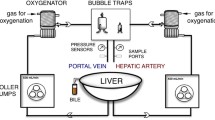Abstract
Hepatic energy metabolism was assessed by measuring the blood ketone body ratio (KBR), that is, the ratio of acetoacetate to β-hydroxybutyrate in the arterial blood, in 31 brain-dead patients in an intensive care unit (ICU) in Japan and in 25 donors just before procurement of the liver for transplantation in Germany. In the study in Japan, 7 of the 12 brain-dead patients treated with highdose catecholamine showed significantly decreased KBRs, revealing the detrimental effect of catecholamine on livermmetabolism. In contrast, 8 of the 9 untreated patients with blood pressure below 80 mm Hg showed almost normal KBRs. In the 25 donors in Germany, KBR was maintained within the normal range. Based upon conventional criteria, 21 livers were selected for use and the other 4 were discarded. Nineteen of the grafts were able to normalize KBR within 24 h after reperfusion, while 2 failed to function and required a second transplantation. It was suggested that a KBR in the normal range in donors is a prerequisite to immediate recovery of metabolic function of the liver graft after transplantation, and that hypotensive donors as a potential source of liver grafts may warrant further study.
Similar content being viewed by others
References
Aler M, Gavaler JS, Duquesnoy R, Fung JJ, Svanas G, Stargl TE, Thiel DH Van (1988) Relationship between the diagnosis, preoperative evaluation and prognosis after orthotopic liver transplantation. Ann Surg 208: 196–202
Asano M, Kamiyama Y, Ozawa K, Tobe T (1983) Evaluation of blood ketone body ratio in assessing critical metabolic dysfunction after hepatic resection. Eur Surg Res 15: 302–311
Bunzendahl H, Ringe B, Meyer HJ, Gubernatis G, Pichlmayr R (1988) Combination harvesting procedure for liver and whole pancreas. Transplant Int 1: 99–102
Commission for the Study Concerning Brain Death, the Ministry of Health and Welfare, Japan (1986) A report in 1985 — Defining brain death and criteria for the determination. Japanese Government Printing Office, Tokyo
Gubernatis G, Bornscheuer A, Taki Y, Farle M, Lübbe N, Beneking M, Burdelski M, Oellerich M (1989) Total oxygen consumption, ketone body ratio and a special score as early indicators of irreversible liver allograft dysfunction. Transplant Proc 21: 2279–2281
Ketone body ratio: an index of multiple organ failure? (Editorial) (1984) Lancet I: 25–26
Lin H, Okamoto R, Yamamoto Y, Ueda J, Tokunaga Y, Maki A, Mori K, Tanaka K, Yamaoka Y, Ozawa K (1989) Hepatic tolerance to hypotension as assessed by the changes in arterial ketone body ratio in the state of brain death. Transplantation 47: 444–448
Makowka L, Gordon RD, Todo S, Ohkohchi N, Marsh JW, Tzakis AG, Yokoi H, Ligush J, Esquivel CO, Satake M, Iwatsuki S, Starzl TE (1987) Analysis of donor criteria for the prediction of outcome in clinical liver transplantation. Transplant Proc 19: 2379–2382
Mellanby J, Williamson DH (1974) Acetoacetate. In: Bergmeyer HU (ed) Methods of enzymatic analysis. Academic Press New York, pp 1446–1451
Ohkohchi N, Satake M, Yokoi H, Makowka L, Todo S, Iwatsuki S (1987) A study of donor procurement in 180 liver transplantation — Analysis of the pretransplant general condition, liver function test and type of the harvest of donors in the liver transplantation. Jpn J Transplant 22: 89–96
Okamoto R, Tokunaga Y, Ozaki N, Kiuchi T, Sakai Y, Okamura R, Utsunomiya H, Ukikusa M, Tanaka K, Yamaoka Y, Ozawa K, Nakase Y (1988) Fluorometric study for the noninvasive determination of cellular viability in perfused rat livers. Transplant Proc 20 [Suppl 1]: 969–971
Okamoto R, Yamamoto Y, Lin H, Ueda J, Yokoyama T, Tanaka K, Shimahara Y, Mori K, Kumada K, Yamaoka Y, Ozawa K (1990) Influence of dopamine on the liver assessed by the changes in arterial ketone body ratio in brain-dead dogs. Surgery 107: 36–42
Ozawa K (1983) Biological significance of mitochondrial redox potential in shock and multiple organ failure — redox theory. In: Lefer AM, Schumer W (eds) Molecular and cellular aspects of shock and trauma. Liss, New York, pp 39–66
Ozawa K, Kamiyama Y, Kimura K, Yamamoto M, Aoyama H, Yasuda K, Tobe T (1983) Contribution of the arterial ketone body ratio to elevated plasma amino acids in hepatic encephalopathy of surgical patients. Am J Surg 146: 299–305
Ozawa K, Tanaka J, Yamamoto M, Kamiyama Y, Tobe T (1983) Metabolic abnormalities associated with postoperative organ failure: a redox theory. Arch Surg 146: 1245–1251
Scudamore CH, Calne RY, Rolles K (1984) The multiple organ donor: the Cambridge experience. Transplant Proc 16: 225–230
Shimahara Y, Ozawa K, Ida T, Ukikusa M, Tobe T (1981) Four stages of mitochondrial deterioration in hemorrhagic shock. Res Exp Med 179: 23–33
Taki Y, Gubernatis G, Yamaoka Y, Oellerich M, Yamamoto Y, Ringe B, Okamoto R, Bunzendahl H, Beneking M, Burdelski M, Bornscheuer A, Pichlmayr R (1990) Significance of arterial ketone body ratio measurement in human liver transplantation. Transplantation 49: 535–539
Tanaka J, Ozawa K, Tobe T (1979) Significance of blood ketone body ratio as an indicator of hepatic cellular energy status in jaundiced rabbits. Gastroenterology 76: 691–696
Tani T, Taki Y, Aoyama H, Jikko A, Arii S, Ozawa K, Tobe T (1986) Changes in acetoacetate/β-hydroxybutyrate ratio in arterial blood following hepatic artery embolization in man. Life Sci 35: 1177–1182
Uno S, Itoh M, Kurono Y, Kamiyama Y, Ozawa K (1987) A simple and sensitive assay for blood ketone bodies using highly purified β-hydroxybutyrate dehydrogenase. Clin Chim Acta 168: 253–255
Williamson DH, Mellanby J (1974) D-(-)-3-hydroxybutyrate. In: Bergmeyer HU (ed) Methods of enzymatic analysis. Academic Press, New York, pp 1836–1839
Yamamoto M, Tanaka J, Ozawa K, Tobe T (1980) Significance of acetoacetate/β-hydroxybutyrate ratio in arterial blood as an indicator of the severity of hemorrhagic shock. J Surg Res 28: 124–131
Author information
Authors and Affiliations
About this article
Cite this article
Yamaoka, Y., Taki, Y., Gubernatis, G. et al. Evaluation of the liver graft before procurement. Transplant Int 3, 78–81 (1990). https://doi.org/10.1007/BF00336208
Received:
Revised:
Accepted:
Issue Date:
DOI: https://doi.org/10.1007/BF00336208




